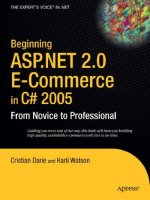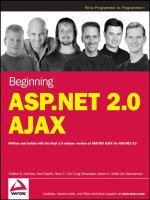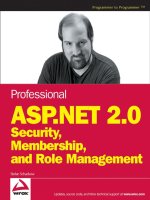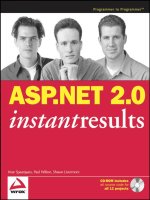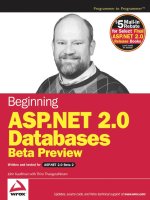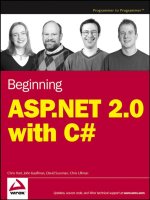beginning asp.net 2.0
Bạn đang xem bản rút gọn của tài liệu. Xem và tải ngay bản đầy đủ của tài liệu tại đây (22.13 MB, 793 trang )
TEAM LinG
Beginning ASP.NET 2.0
01_588508 ffirs.qxd 10/10/05 6:28 PM Page i
01_588508 ffirs.qxd 10/10/05 6:28 PM Page ii
Beginning ASP.NET 2.0
Chris Hart, John Kauffman, Dave Sussman, and Chris Ullman
01_588508 ffirs.qxd 10/10/05 6:28 PM Page iii
Beginning ASP.NET 2.0
Published by
Wiley Publishing, Inc.
10475 Crosspoint Boulevard
Indianapolis, IN 46256
www.wiley.com
Copyright © 2006 by Wiley Publishing, Inc., Indianapolis, Indiana
Published simultaneously in Canada
ISBN-13: 978-0-7645-8850-1
ISBN-10: 0-7645-8850-8
Manufactured in the United States of America
10 9 8 7 6 5 4 3 2 1
1B/SW/RQ/QV/IN
Library of Congress Cataloging-in-Publication Data is available from the Publisher.
No part of this publication may be reproduced, stored in a retrieval system or transmitted in any form or by
any means, electronic, mechanical, photocopying, recording, scanning or otherwise, except as permitted
under Sections 107 or 108 of the 1976 United States Copyright Act, without either the prior written permis-
sion of the Publisher, or authorization through payment of the appropriate per-copy fee to the Copyright
Clearance Center, 222 Rosewood Drive, Danvers, MA 01923, (978) 750-8400, fax (978) 646-8600. Requests to
the Publisher for permission should be addressed to the Legal Department, Wiley Publishing, Inc., 10475
Crosspoint Blvd., Indianapolis, IN 46256, (317) 572-3447, fax (317) 572-4355, or online at http://www.
wiley.com/go/permissions.
LIMIT OF LIABILITY/DISCLAIMER OF WARRANTY: THE PUBLISHER AND THE AUTHOR MAKE
NO REPRESENTATIONS OR WARRANTIES WITH RESPECT TO THE ACCURACY OR COMPLETENESS
OF THE CONTENTS OF THIS WORK AND SPECIFICALLY DISCLAIM ALL WARRANTIES, INCLUDING
WITHOUT LIMITATION WARRANTIES OF FITNESS FOR A PARTICULAR PURPOSE. NO WARRANTY
MAY BE CREATED OR EXTENDED BY SALES OR PROMOTIONAL MATERIALS. THE ADVICE AND
STRATEGIES CONTAINED HEREIN MAY NOT BE SUITABLE FOR EVERY SITUATION. THIS WORK IS
SOLD WITH THE UNDERSTANDING THAT THE PUBLISHER IS NOT ENGAGED IN RENDERING
LEGAL, ACCOUNTING, OR OTHER PROFESSIONAL SERVICES. IF PROFESSIONAL ASSISTANCE IS
REQUIRED, THE SERVICES OF A COMPETENT PROFESSIONAL PERSON SHOULD BE SOUGHT.
NEITHER THE PUBLISHER NOR THE AUTHOR SHALL BE LIABLE FOR DAMAGES ARISING HERE-
FROM. THE FACT THAT AN ORGANIZATION OR WEBSITE IS REFERRED TO IN THIS WORK AS A
CITATION AND/OR A POTENTIAL SOURCE OF FURTHER INFORMATION DOES NOT MEAN THAT
THE AUTHOR OR THE PUBLISHER ENDORSES THE INFORMATION THE ORGANIZATION OR
WEBSITE MAY PROVIDE OR RECOMMENDATIONS IT MAY MAKE. FURTHER, READERS SHOULD BE
AWARE THAT INTERNET WEBSITES LISTED IN THIS WORK MAY HAVE CHANGED OR DISAP-
PEARED BETWEEN WHEN THIS WORK WAS WRITTEN AND WHEN IT IS READ.
For general information on our other products and services please contact our Customer Care Department
within the United States at (800) 762-2974, outside the United States at (317) 572-3993 or fax (317) 572-4002.
Trademarks: Wiley, the Wiley logo, Wrox, the Wrox logo, Programmer to Programmer, and related trade
dress are trademarks or registered trademarks of John Wiley & Sons, Inc. and/or its affiliates, in the United
States and other countries, and may not be used without written permission. All other trademarks are the
property of their respective owners. Wiley Publishing, Inc., is not associated with any product or vendor
mentioned in this book.
Wiley also publishes its books in a variety of electronic formats. Some content that appears in print may not
be available in electronic books.
01_588508 ffirs.qxd 10/10/05 6:28 PM Page iv
Chris Ullman: All my love to my wife Kate and the boys.
01_588508 ffirs.qxd 10/10/05 6:28 PM Page v
01_588508 ffirs.qxd 10/10/05 6:28 PM Page vi
About the Authors
Chris Hart
Chris works full-time as a developer at Trinity Expert Systems Plc, based in Coventry (UK), where she’s
worked on several major .NET, SharePoint, and CMS applications. She enjoys having a job where she
gets to learn and play with new technologies on a regular basis, often working on-site with customers.
She’s been using .NET since the pre-Alpha days, and yet still enjoys the fun of working with beta
software.
Chris lives in Birmingham (UK, not Alabama) with her extremely understanding husband James, as she
tries to fit writing alongside her hectic job and her attempts at gardening. She collects computers in
much the same way as some old ladies collect cats.
Chris Hart contributed Chapters 3–5 and 11 and Appendix C to this book.
John Kauffman
John Kauffman was born in Philadelphia, the son of a chemist and a nurse. He received his degrees from
The Pennsylvania State University, the colleges of Science and Agriculture. His early research was for
Hershey foods in the genetics of the chocolate tree and the molecular biology of chocolate production.
Since 1993, John has focused on explaining technology in the classroom and in books.
In his spare time, John is an avid sailor and youth sailing coach. He also enjoys jazz music and drum-
ming. In addition to technical material, he manages to read the New Yorker magazine from cover-to-cover
each week.
John Kauffman contributed Chapters 1, 2, 7, and 8 and Appendix D to this book.
Dave Sussman
Dave Sussman is an independent trainer, consultant, and writer, who inhabits that strange place called
beta land. It’s full of various computers, multiple boot partitions, VPC images, and very occasionally,
stable software. When not writing books or testing alpha and beta software, Dave can be found working
with a variety of clients helping to bring ASP.NET projects into fruition. He is a Microsoft MVP, and a
member of the ASP Insiders and INETA Speakers Bureau. You can find more details about Dave and his
books at his official Web site (www.ipona.com) or the site he shares with Alex Homer (http://dave
andal.net).
Dave Sussman contributed Chapters 6, 9, 14, and 15 and Appendix E to this book.
01_588508 ffirs.qxd 10/10/05 6:28 PM Page vii
Chris Ullman
Chris Ullman is a freelance web developer and technical author who has spent many years stewing in
ASP/ASP.NET, like a teabag left too long in the pot. Coming from a Computer Science background, he
started initially as a UNIX/Linux guru, who gravitated toward MS technologies during the summer of
ASP (1997). He cut his teeth on Wrox Press ASP guides, and since then he has written on more than 20
books, most notably as lead author for Wrox’s bestselling Beginning ASP/ASP.NET 1.x series, and has
contributed chapters to books on PHP, ColdFusion, JavaScript, Web Services, C#, XML, and other
Internet-related technologies too esoteric to mention, now swallowed up in the quicksands of the
dot.com boom.
Quitting Wrox as a full-time employee in August 2001, he branched out into VB.NET/C# programming
and ASP.NET development and started his own business, CUASP Consulting Ltd, in April 2003. He
maintains a variety of sites from www.cuasp.co.uk, his “work” site, to www.atomicwise.com, a
selection of his writings on music and art. The birth of his twins, Jay and Luca, in February 2005 took
chaos to a new level. He now divides his time between protecting the twins from their over-affectionate
three-year-old brother Nye, composing electronic sounds on bits of dilapidated old keyboards for his
music project, Open E, and tutoring his cats in the art of peaceful coexistence, and not violently mugging
each other on the stairs.
Chris Ullman contributed Chapters 10, 12, 13, and 16 and Appendix B to this book.
01_588508 ffirs.qxd 10/10/05 6:28 PM Page viii
Credits
Senior Acquisitions Editor
Jim Minatel
Development Editor
Brian Herrmann
Technical Editor
Dan Maharry
Production Editor
Felicia Robinson
Copy Editor
Kim Cofer
Editorial Manager
Mary Beth Wakefield
Production Manager
Tim Tate
Vice President & Executive Group Publisher
Richard Swadley
Vice President and Publisher
Joseph B. Wikert
Project Coordinator
Ryan Steffen
Graphics and Production Specialists
Andrea Dahl
Carrie Foster
Lauren Goddard
Denny Hager
Joyce Haughey
Jennifer Heleine
Stephanie D. Jumper
Lynsey Osborn
Alicia B. South
Quality Control Technician
Leeann Harney
Proofreading
Sossity R. Smith
Indexing
TECHBOOKS Production Services
01_588508 ffirs.qxd 10/10/05 6:28 PM Page ix
01_588508 ffirs.qxd 10/10/05 6:28 PM Page x
Contents
Acknowledgments xxi
Introduction xxiii
Who This Book Is For xxiii
What This Book Covers xxiv
Chapter 1: An Introduction to ASP.NET 2.0 and the Wrox United Application xxiv
Chapter 2: Site Design xxiv
Chapter 3: Page Design xxiv
Chapter 4: Membership and Identity xxv
Chapter 5: Styling with Themes xxv
Chapter 6: Events and Code xxv
Chapter 7: Reading Data xxv
Chapter 8: Writing Data xxv
Chapter 9: Code xxv
Chapter 10: Componentization xxv
Chapter 11: Roles and Profiles xxvi
Chapter 12: Web Services xxvi
Chapter 13: E-Commerce xxvi
Chapter 14: Performance xxvi
Chapter 15: Dealing with Errors xxvi
Chapter 16: Deployment, Builds, and Finishing Up xxvi
How This Book Is Structured xxvii
What You Need to Use This Book xxvii
Conventions xxvii
Source Code xxviii
Errata xxviii
p2p.wrox.com xxix
Chapter 1: An Introduction to ASP.NET 2.0 and the Wrox United Application 1
The Site You Will Build 3
ASP.NET 2.0 — A Powerful Tool to Build Dynamic Web Sites 4
Simple Solutions for Common Web Site Tasks 5
Consistency and Personalization 5
Navigation 5
Login, Security, and Roles 5
Connection to Data 6
Code 6
02_588508 ftoc.qxd 10/10/05 6:27 PM Page xi
xii
Contents
Componentization 6
Web Services 6
Performance and Caching 7
Errors and Exception Handling 7
Deployment 7
Development Tools 7
Where Does ASP.NET 2.0 Fit with Other Technology? 8
Exploring the Wrox United Application 9
Getting Started with Your Wrox United Site 10
VWD Express — A Development Environment 10
Introducing Cassini 11
VWD’s Solution Explorer 11
Creating, Opening, and Using Web Sites and Pages with VWD 14
The Sample Code Directories 14
Running a Page 16
Design Surface 17
Toolbox 18
Properties Window 21
Error List Window 22
VWD’s Database Explorer 25
Summary 26
Exercises 26
Chapter 2: Site Design 29
General Design Objectives 30
Master and Content Pages 31
Creating a Master Page 31
Creating Content Pages 33
A Sample of Master and Content Pages 35
Using Cascading Style Sheets in a Master Page 36
Additional Capabilities of Master Pages 42
Multiple Levels of Master Pages 42
Master Pages Support Multiple Content Placeholders 43
Creating a Site Map 44
General Guidelines for Site Design 47
Standard Files for ASP.NET 2.0 Applications 47
Web.config Holds Settings for the Entire Site 48
Global.asax Holds Code for the Entire Site 52
Editing Site Configuration Through a Web Browser 52
Troubleshooting Site Design Errors 55
Summary 55
Exercises 56
02_588508 ftoc.qxd 10/10/05 6:27 PM Page xii
xiii
Contents
Chapter 3: Page Design 57
Static Page Design 57
The World of HTML 65
From HTML to XHTML Code 68
Dynamic Content 70
Dynamic Client Code and Dynamic Server Code 71
Introduction to Server Controls 72
The Server Control Toolbox 72
What Are Server Controls? 73
Source View in VWD 78
Types of Server Controls 83
Standard Controls 83
HTML Controls 84
Navigation Controls 86
Summary 102
Exercises 103
Chapter 4: Membership and Identity 105
Security Basics 106
Identity — Who Am I? 106
Authentication — This Is Who I Am 106
Authorization — This Is What I Can Do 106
Logging In to a Site 107
ASP.NET Security 107
Login Controls 107
Personalization 121
Membership 124
Authentication 130
Wrox United Security 132
Summary 136
Exercises 136
Chapter 5: Styling with Themes 137
Styling a Site 137
Style Attributes 138
CSS — Cascading Style Sheets 142
Themes 151
Applying Styling to a Site 168
Themes in Wrox United 171
02_588508 ftoc.qxd 10/10/05 6:27 PM Page xiii
xiv
Contents
Styling and Layout Best Practices 177
Usability 177
Accessibility 178
Summary 179
Exercises 179
Chapter 6: Events and Code 181
Web Server Architecture 181
HTTP Is Stateless 182
Server-Side Events 183
Adding Events to the Page 184
The Postback Architecture 190
What Events Are Available? 191
Which Events Should I Use? 193
Events Aren’t Triggered by Users Only 195
Indirect Events 200
Canceling Events 203
Global Events 206
Summary 207
Exercises 208
Chapter 7: Reading Data 209
Introducing Databases 210
Using ASP.NET 2.0’s Data Controls 211
Introducing Data Source Controls 211
Introducing Data-Bound Controls 212
Data Source Controls and Data-Bound Controls Work Together 216
Configuring Data Controls with VWD 217
Data Source Controls 217
The Basic Properties of Data Source Controls 218
Hiding the Connection String 221
Details of the Connection String and Provider 223
Data-Bound Controls 224
Data-Bound Selection Lists 224
The GridView Control 230
The DataList and Repeater Controls 236
The DetailsView and FormView Controls 244
Data Source Controls with Parameters 247
02_588508 ftoc.qxd 10/10/05 6:27 PM Page xiv
xv
Contents
Multiple Data Controls Working Together 252
Working with XML Data 258
Reading XML Data 260
Binding Syntax 262
Summary 263
Exercises 264
Chapter 8: Writing Data 265
Introduction to Writing Data 265
Options for Writing Data 266
DataKeyNames 266
Changing Existing Records 267
Adding New Records 273
Deleting Records 275
Uploading Pictures 278
Improving the Upload of Pictures 281
Summary 286
Exercises 287
Chapter 9: Code 289
Variables and Data Types 289
Common Language Runtime Types 291
Declaring Variables 292
Assigning Values 292
Data Conversion 293
Null Values 295
Working with Strings 295
Working with Dates 297
Working with Arrays and Collections 301
Deciding Whether to Use Arrays or Collections 307
Enumerations 307
Constants 309
Statements 310
Operators 310
Decisions 317
Loops 320
Namespaces 328
Working with Classes 329
Creating Classes 330
Inheritance 339
02_588508 ftoc.qxd 10/10/05 6:27 PM Page xv
xvi
Contents
Variable Scope and Lifetime 344
Generics 345
Summary 346
Exercises 347
Chapter 10: Componentization 349
The Separation of Code from Content 350
The Separation of Code from Design 351
Code-Behind 352
The Page Directive 352
Partial Classes 353
Event Handlers/Functions 353
Creating a Code-Behind File 354
Compilation in ASP.NET 2.0 357
The App_Code Folder 359
Data Layers 359
Two-Tier Applications 359
Three-Tier Applications 360
What’s New in ASP.NET 2.0 361
The Wrox United ObjectDataSource 367
User Controls 370
User Control Structure 372
A Simple User Control 373
The Wrox United News User Control 377
Composite Controls 382
Assemblies and Custom Server Controls 382
Summary 383
Exercises 383
Chapter 11: Roles and Profiles 385
The Importance of Roles 386
Introducing Roles in Wrox United 387
Configuring Page-Level Authorization 397
Controlling Page Visibility 399
Working with Roles in Code 406
Enabling User Profiles 407
Building a Profile 408
Profiles in Wrox United 410
Storing Preferences 418
Managing Anonymous Shopping Carts 424
Summary 425
Exercises 426
02_588508 ftoc.qxd 10/10/05 6:27 PM Page xvi
xvii
Contents
Chapter 12: Web Services 427
Looking at Web Services 428
Consuming a Third-Party Web Service 429
The Life Cycle of a Web Service 433
Calling the Web Service 433
Transmitting the Web Service 434
Returning the Response 436
Using the Response 438
The Structure of Your Web Service 438
Processing Directive 438
Namespaces 439
Public Class 439
Web Methods 439
Creating a Web Service 441
Testing Your Web Service 444
The WSDL Contract 446
Web Service Discovery 447
DISCO 448
UDDI 448
Discovering Your Web Service 448
Adding the Fixture Service to Your Application 451
Putting It All Together 454
Remote Web Services — PocketPC Application 458
Web Service Security 463
Encryption and Message-Based Security 463
Authentication and Access Controls for Services 463
Summary 464
Exercises 464
Chapter 13: E-Commerce 465
The E-Commerce Pipeline 466
The Product Catalog 467
The Structure of the Catalog 467
The Design of the Catalog 467
Implementation of the Catalog 468
The Product Item Page 475
The Shopping Cart 481
The Shopping Object 482
The Profile 490
The Shopping Cart Control 492
02_588508 ftoc.qxd 10/10/05 6:27 PM Page xvii
xviii
Current HeadContents
Checkout 505
Order Processing 506
Login 506
Address/Delivery Details 506
Credit Card Handling 507
How You Intend to Checkout 508
Secure Transactions 523
What Else Can You Do? 524
Summary 524
Exercises 525
Chapter 14: Performance 527
Simple Techniques 527
Object Disposal 528
Database Connections 531
Stored Procedures 531
Strongly Typed Collections 540
Session State 541
View State 542
Pages and Code 543
Data Binding and Postback 543
Object References 544
StringBuilder Versus String Concatenation 544
Picking the Right Collection 546
Caching 547
Page Caching 547
Designing for Performance 552
Web Server Hardware and Software 553
Testing Performance 553
Tracing 554
Stress Testing Tools 556
Performance Monitor 557
Summary 557
Exercises 557
Chapter 15: Dealing with Errors 559
Defensive Coding 559
Parameter Checking 560
Avoiding Assumptions 561
Query Parameters 562
Validation 563
02_588508 ftoc.qxd 10/10/05 6:27 PM Page xviii
xix
Contents
Exception Handling 568
What Are Exceptions? 569
The Exception Object 569
How to Trap Exceptions 570
Logging Exceptions 576
Mailing Exceptions 580
Raising Exceptions 582
Exceptions Best Practices 582
Global Exception Handling 583
Custom Error Pages 585
Configuring Custom Error Pages 585
Debugging and Tracing 587
Using ASP.NET Tracing 587
Using the Debugger 592
Summary 599
Exercises 600
Chapter 16: Deployment, Builds, and Finishing Up 601
Site Deployment 602
Checklist 602
Compiling and Running Your Application 603
Publishing the Site 604
XCOPY Deployment 609
Common Problems Encountered When Deploying a Site 611
Testing and Maintenance 615
Testing Before and After 615
Maintenance 616
Where To Now? 623
References 623
Summary 624
Exercises 624
Appendix A: Exercise Answers 625
Appendix B: Setup 653
Appendix C: Wrox United Database Design 671
02_588508 ftoc.qxd 10/10/05 6:27 PM Page xix
xx
Contents
Appendix D: VWD Database Explorer 679
Appendix E: CSS and HTML Quick Reference 699
Index 723
02_588508 ftoc.qxd 10/10/05 6:27 PM Page xx
xxi
Acknowledgments
Chris Hart
I’d like to thank James for sharing me with a laptop while I wrote this book—this was the hardest one
yet, and you were great. Thanks also to my brother Rob for your inspiring creativity—best of luck in
your final year at Uni. Finally, big thanks to Lou for designing the Wrox United site, and for being such a
fantastic friend.
John Kauffman
I gratefully acknowledge the help of the Microsoft ASP.NET 2.0 development team, particularly Bradley
Millington. It was Brad who first demonstrated the enormous capability of the ASP.NET 2.0 data con-
trols to me and has continued to tutor in the best use of the code his team developed. I also deeply
appreciate the ongoing advice and friendship of my co-author Dave Sussman.
Dave Sussman
I would like to thank everyone on the ASP.NET team for supplying interim builds and answering many
questions; Dan Maharry for his invaluable reviewing; and Brian Herrmann for coping admirably with
not only my writing, but also my occasional stroppy fits.
Chris Ullman
Thanks to everyone on the author team (Dave, Chris, and John) for being available for my Messenger
and e-mail queries, thanks to Dan for being an honest reviewer and always ready with good advice, and
thanks to Jim and Brian for being patient on the chapters—I got there eventually!
03_588508 flast.qxd 10/10/05 6:21 PM Page xxi
03_588508 flast.qxd 10/10/05 6:21 PM Page xxii
Introduction
Many different technologies are available today for developing complex web sites and web applications,
and with so many to choose from, it’s great that there’s one technology in particular that stands out from
the crowd and is such a joy to use. ASP.NET 2.0 is a fantastic technology that enables you to develop
web sites and applications with very little hassle. Developing web applications was never this easy, yet
even though it may appear simple, there is real power and depth to this technology that enables it to
host even the most complex applications available today.
With every new release from Microsoft comes a new way of thinking, new technologies designed to
make your life easier, and the best-ever programming experience; ASP.NET 2.0 is no exception to this
rule. Whether you have developed web applications before, or if you are completely new to the world of
web development, there’s a lot to learn about this particular version of the technology.
Built on top of version 2.0 of the .NET Framework, ASP.NET 2.0 extends on the functionality first seen in
ASP.NET 1.0 and 1.1. At its core, you have a control-based, event- driven architecture, which means that
you have the ability to add small blocks of code to a page, and see dynamic results with minimal effort,
and you can react to user input to provide a smooth and intuitive user experience.
The biggest change since the previous edition of ASP.NET is in the amount of code you have to write—
the ASP.NET team aimed for a 70% reduction in the amount of code you write, and having spent time
myself working with ASP.NET 2.0 in the field, even if this claim does sound somewhat large, the reduc-
tion in time spent with fingers on keys is very noticeable. The mundane and repetitive tasks that you
would have previously had to complete have been simplified. For example, providing user login func-
tionality to a site is now a very swift process—adding a few controls to a page and setting up some user
accounts is pretty much all you need to do to get basic user login functionality implemented on a site,
and personalizing the user experience is just a step away from there!
Now add the new development environment designed for building ASP.NET 2.0 applications, Visual
Web Developer (available on its own, or as part of Visual Studio 2005), and you will find building
dynamic, feature-rich applications to be a fast, smooth process.
Visual Web Developer is a new innovation from Microsoft, and was developed mostly in response to
developer demand. Previous editions of Visual Studio .NET were not great when it came to web pro-
gramming, and you’d often find your code had been “fixed” for you behind the scenes because your
HTML came out looking very different thanthe way it went in originally! Visual Web Developer has a
fantastic HTML editing environment, and a really smooth and intuitive interface for developing com-
plex ASP.NET applications. Best of all, it’s a low-cost product, which makes it accessible to a wide audi-
ence who may not be able to afford the complete Visual Studio package.
Who This Book Is For
This book teaches you how to program web applications in ASP.NET 2.0 that can display data stored in a
database, provide a personalized user experience to your users, and even offer shopping functionality.
03_588508 flast.qxd 10/10/05 6:21 PM Page xxiii
xxiv
Introduction
All of these sorts of web applications can be developed using ASP.NET 2.0, so if these are the sorts of
applications that you are interested in developing, then this is a great place to start!
This book is for anyone new to web programming, or who has a small amount of knowledge of web pro-
gramming concepts. Maybe you want to start a career as a web developer? Or perhaps you just want to
learn how to use some cool server-side technology to put together some sites in your spare time? In
either case, this book teaches you what you need to know, and gives you a good feel for how the tech-
nology works, how to use the Visual Web Developer environment to speed up your development, and to
give you total control over the development process.
The early chapters in this book ease you into the world of ASP.NET development, and if you already
have some knowledge of programming, you will find these early chapters a swift and pleasant read.
Note, though, that ASP.NET 2.0 has a lot of neat tricks and tools at its disposal, and we’ll be introducing
these throughout the book. As with other Wrox Beginning books, you should find that the concepts dis-
cussed in one chapter are then used and extended in other chapters.
What This Book Covers
This book teaches you ASP.NET 2.0, with the help of the Visual Web Developer IDE (Integrated
Development Environment). Working through this book, you will learn how to develop powerful data-
driven web applications, and even to expose functionality using web services. Here’s how the book
shapes up over the next 16 chapters.
Chapter 1: An Introduction to ASP.NET 2.0 and the Wrox
United Application
This chapter provides an overview of ASP.NET 2.0 and the Visual Web Developer environment, and
gives you a chance to create and run a simple page. You’ll also learn about the Wrox United sample web
site, which is used in examples throughout the book to demonstrate different aspects of ASP.NET 2.0.
Chapter 2: Site Design
Now that you’ve gained some familiarity with creating simple pages, this chapter discusses the concept
of site design, and introduces the concept of a Master page, which can be used to provide a consistent
look for all pages on a site. It also introduces
Web.config and Global.asax—two important ASP.NET
files that control the behavior of a site, and the concept of a site map, for defining a site page hierarchy.
Chapter 3: Page Design
This chapter starts by providing a quick crash-course (or a refresher course as the case may be) in HTML
and XHTML development, and introduces the crucial concept of server controls. The chapter continues by
demonstrating several of the built-in server controls in action to provide navigation functionality on a site.
03_588508 flast.qxd 10/10/05 6:21 PM Page xxiv

